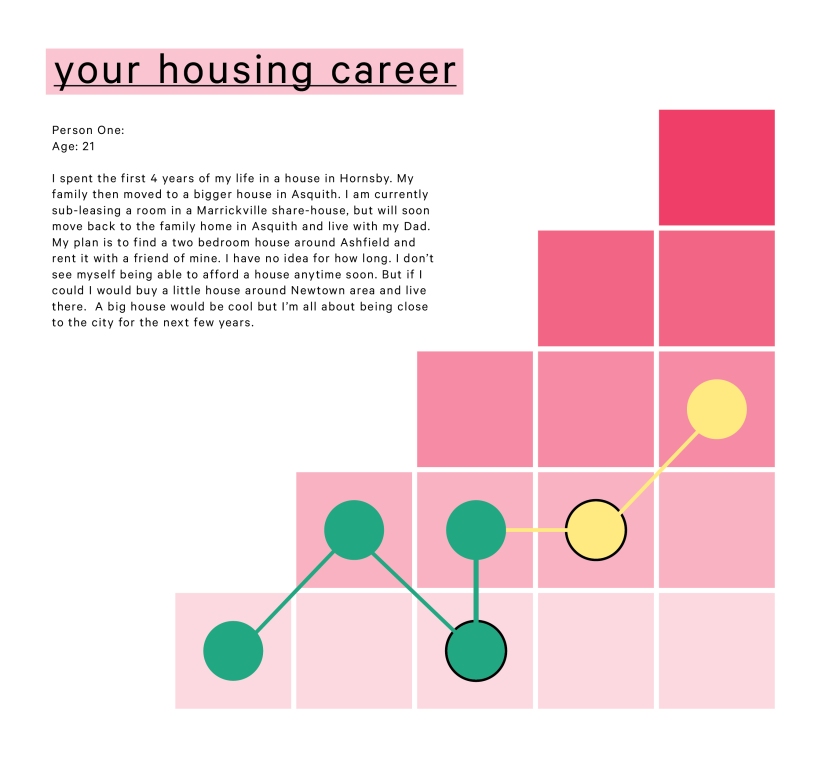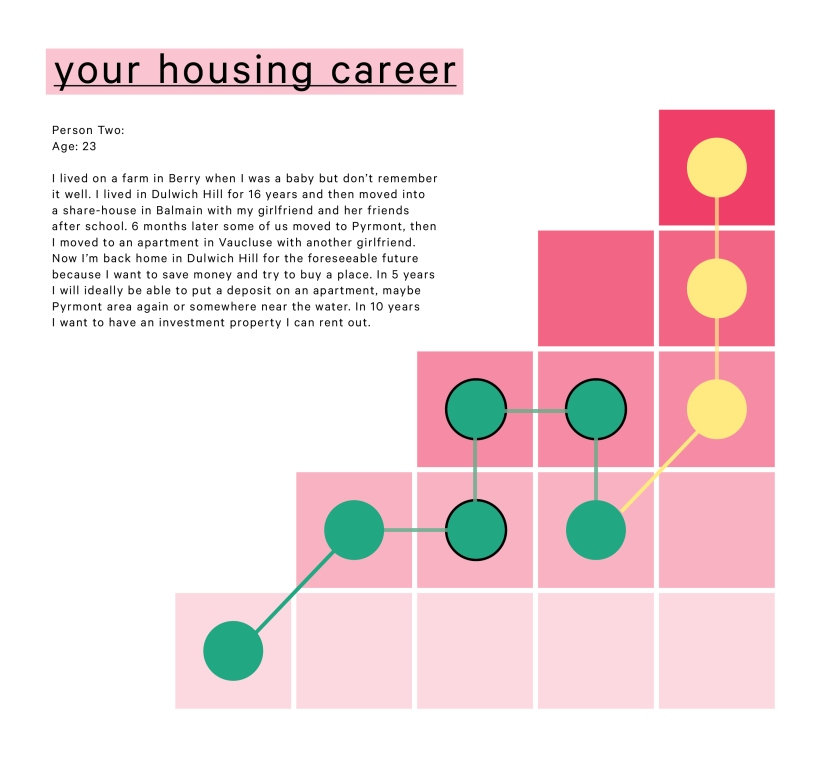INTERVIEW
I conducted an unstructured interview with a fellow student. Due to the length and conversational structure I have summarised the interview into key insights. We talked about my interviewee’s housing career: they grew up in Adelaide then moved to Sydney with their family. They still live at home but have a surprisingly strong, well-thought out vision for their future housing. Once working full-time they plan to move out but preferably not rent for a long time. In ten years time they definitely want to own an investment property and see this as something very important to being financially secure. How they will afford an investment property, they are unsure, but they are adamant it is a better option than other potential investments. They also touched on the topic of migrants living in Sydney, working on low wages, sending money home and therefore living in inadequate conditions.
KEY INSIGHTS
From the interview and probe I drew the following key insights:
- Young people are disillusioned with breaking into the housing market.
- Housing is seen as the safest investment. Sydney houses are guaranteed to increase in value at a significant rate.
- When it comes to housing, everyone has a story and everyone is passionate about where and how comfortably they live.
- There is a prevailing ‘dream’ or conventional ‘housing career’ – living at home, then renting briefly, then owning a home, then buying investment properties and/or moving upwards – this is no longer the norm.
- Considering my target audience (18-25 year olds) I should start to focus more on rental affordability, a growing issue that is more directly relevant to Sydney youth.
PROBE
After my interview I was able to focus on a few key areas to focus on. First, I wanted to see if more young people had an idealistic view of their housing career. Second, I then wanted to start to consider rental affordability as everyone I am talking to is many, many years from buying a home. Indeed, my generation may be lifelong renters, or at least long-term renters.
I branched out and talked to two other young people. I asked them to plot their housing career on a ladder – harking back to this idea of an idyllic housing career where you continue to move up the property market step-by-step. Each step of the probe asks a question, starting with their history of housing, moving through the present, and looking at their aspirations.
I sent the participants the following instructions and created the following two plots to reflect their answers.
Plot you housing career to-date (in green). Moves can be lateral or vertical, determined by whether you felt your were moving ‘up’, ‘down’ or ‘across’ in terms of house value, living conditions and financial situation. Now, continue the plot with your future aspirations when it comes to housing (in yellow). Place a black outline on properties you are renting.
Write a short description of your housing career and for each move try to include details on location, type of dwelling, size, who you lived with and whether you owned or rented.


Was the probe successful?
The probe was helpful in giving me a richer picture of the challenges young people face and also have faced. Even though you aren’t the homeowner, growing up you pick up a lot of insight about your home and area. Everyone has a story to tell when it comes to housing. To improve the probe it would need more variety, a larger sample and more diverse people. Even limiting the probe to university students, mature-age and international students have unique insights that would be valuable. Further, the information gathered was useful to me, but, what would be more interesting is a public forum where each person involved shared their story and housing aspirations with the group. This could really start to challenge this notion that we all hold unrealistic and idealistic impressions of a housing career.
Perhaps the image of a staircase is not entirely appropriate. Housing is better depicted as a series of stepping stones; the stones don’t progressively get bigger or more valuable, but each stone provides a level of security we need at that time. To extend the metaphor, a cascading river shows how important housing is to our lives. Your house affects everything from where you are able to work, whether you commute for four hours a day, whether you stay healthy, whether you can drop the kids to school each morning, whether you get that job you deserve or instead have an interviewer scoff at your postcode. Whether you own a house at 30, or rent at 40, or borrow against the house at 50 to start a business, your housing career is unpredictable but it is a crucial part of living. Thus, it seems foolish that the youth is chasing a dream created by their parents generation that is no longer achievable. Moreover, it seems unjust that politicians, who are removed from the housing crisis the younger generations are facing, should hold so much power over where and how we live – factors that affect all aspects of our lives.
You must be logged in to post a comment.